Dr. Andrew Olinde has been named one of the Best Doctors in America® for 2017-2018. The prestigious recognition marks the eleventh time that Dr. Andrew Olinde has earned this honor. He was the only Vascular Surgeon to receive this award in Baton Rouge.
The highly regarded Best Doctors in America® List, assembled by Best Doctors, Inc. and audited and certified by Gallup® results from exhaustive polling of close to 40,000 physicians in the United States. In a confidential review, current physician listees answer the question, “If you or a loved one needed a doctor in your specialty, to whom would you refer?” Best Doctors, Inc. evaluates the review results, and verifies all additional information to meet detailed inclusion criteria.
Best Doctors has earned a sterling reputation for reliable, impartial results by remaining totally independent. Doctors cannot pay to be included in the Best Doctors database, nor are they paid to provide their input. The List is a product of validated peer review, in which doctors who excel in their specialties are selected by their peers in the profession.
Over the past 20 years, Best Doctors has earned global acclaim for its remarkable database of physicians, regarded as the world’s premier effort to create a validated, peer-reviewed database of excellence in medicine. The Best Doctors methodology is rigorously impartial and strictly independent; only those doctors recognized as the top 4% of their respective specialty earn the honor of being named one of the Best Doctors in America. The experts who are a part of the Best Doctors in America database provide the most advanced medical expertise and knowledge to patients with serious conditions – often saving lives in the process by finding the right diagnosis and right treatment.
